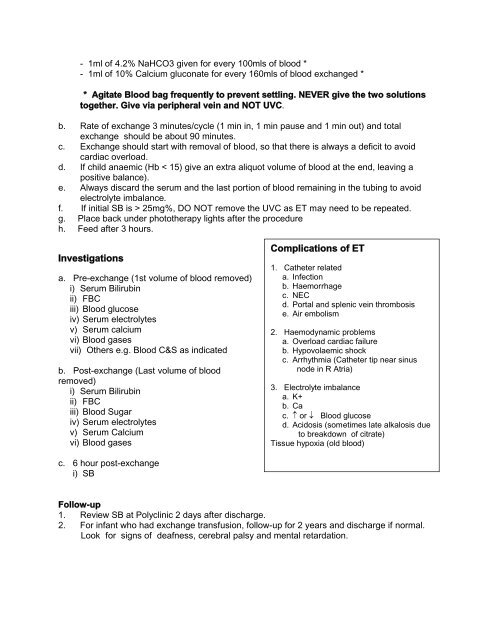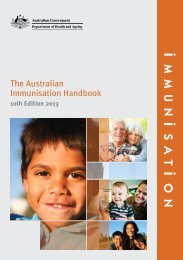Contents Chapter Topic Page Neonatology Respiratory Cardiology
Contents Chapter Topic Page Neonatology Respiratory Cardiology
Contents Chapter Topic Page Neonatology Respiratory Cardiology
You also want an ePaper? Increase the reach of your titles
YUMPU automatically turns print PDFs into web optimized ePapers that Google loves.
- 1ml of 4.2% NaHCO3 given for every 100mls of blood *<br />
- 1ml of 10% Calcium gluconate for every 160mls of blood exchanged *<br />
* Agitate Blood bag frequently to prevent settling. NEVER give the two solutions<br />
together. Give via peripheral vein and NOT UVC.<br />
b. Rate of exchange 3 minutes/cycle (1 min in, 1 min pause and 1 min out) and total<br />
exchange should be about 90 minutes.<br />
c. Exchange should start with removal of blood, so that there is always a deficit to avoid<br />
cardiac overload.<br />
d. If child anaemic (Hb < 15) give an extra aliquot volume of blood at the end, leaving a<br />
positive balance).<br />
e. Always discard the serum and the last portion of blood remaining in the tubing to avoid<br />
electrolyte imbalance.<br />
f. If initial SB is > 25mg%, DO NOT remove the UVC as ET may need to be repeated.<br />
g. Place back under phototherapy lights after the procedure<br />
h. Feed after 3 hours.<br />
Investigations<br />
a. Pre-exchange (1st volume of blood removed)<br />
i) Serum Bilirubin<br />
ii) FBC<br />
iii) Blood glucose<br />
iv) Serum electrolytes<br />
v) Serum calcium<br />
vi) Blood gases<br />
vii) Others e.g. Blood C&S as indicated<br />
b. Post-exchange (Last volume of blood<br />
removed)<br />
i) Serum Bilirubin<br />
ii) FBC<br />
iii) Blood Sugar<br />
iv) Serum electrolytes<br />
v) Serum Calcium<br />
vi) Blood gases<br />
c. 6 hour post-exchange<br />
i) SB<br />
Complications of ET<br />
1. Catheter related<br />
a. Infection<br />
b. Haemorrhage<br />
c. NEC<br />
d. Portal and splenic vein thrombosis<br />
e. Air embolism<br />
2. Haemodynamic problems<br />
a. Overload cardiac failure<br />
b. Hypovolaemic shock<br />
c. Arrhythmia (Catheter tip near sinus<br />
node in R Atria)<br />
3. Electrolyte imbalance<br />
a. K+<br />
b. Ca<br />
c. or Blood glucose<br />
d. Acidosis (sometimes late alkalosis due<br />
to breakdown of citrate)<br />
Tissue hypoxia (old blood)<br />
Follow-up<br />
1. Review SB at Polyclinic 2 days after discharge.<br />
2. For infant who had exchange transfusion, follow-up for 2 years and discharge if normal.<br />
Look for signs of deafness, cerebral palsy and mental retardation.
















